Beauty and Beast
And art thou, then, a world like ours,
Flung from the orb that whirled our own
A molten pebble from its zone?
How must the burning sands absorb
The fire-waves of the blazing orb,
Thy chain so short, thy path so near
Thy flame-defying creatures hear
The maelstrom of the photosphere!
– Oliver Wendell Holmes, The Flâneur
When, in 1882, Venus appeared to pass in front of the Sun’s disc in an event known as a transit, little was known of the planet, except perhaps that it was one of the brightest objects in the night sky (third only to the Sun and Moon) and that it was both the “morning star” and the “evening star”. Much about Venus, and even the Sun, was therefore left to the imagination, and this is what gave the doctor, poet, and amateur astronomer Oliver Wendell Holmes the liberty to write the preceding verse. As can be surmised from Holmes’s poem, which was inspired by his witnessing the 1882 transit of Venus, he imagined the planet – “a world like ours” – to be populated by “flame-defying creatures” who would be audience to the “maelstrom of the photosphere.”
To put Holmes’s romantic visualization of Venus in context, note that in 1882, space probes are yet to be sent to Venus. In fact, space exploration hasn’t begun then. (The world had to wait for nearly three quarters of a century for the first space probe.) The most intriguing aspect of Venus known to scientists at the time of the 1882 transit came from the poet and astronomer Mikhail Lomonosov who, in 1761, discovered that Venus had a substantial atmosphere. But even under the intense scrutiny of generations of starry-eyed telescope users, Venus refused to give up her secrets. Ironically, the same atmosphere that made Venus so alluring, and that made her the brightest object in a moonless night sky, also constantly veiled her from the prying eyes of astronomers. Since her cloud cover never parted, successions of space lovers were given the freedom to imagine what lies beneath Venus’s curtain of vapours. Thus Holmes’s The Flâneur.
Witnesses to this year’s transit of Venus do not have the freedom Holmes had. Such is the price of knowledge. But what we now know about the Earth’s “twin planet” is no tether to the imagination. In fact, as usual in science, reality has shown that our wildest imaginations are barely wild enough to match what’s really out there. After the fly-by mission of 18 space probes, and after 17 landings that lasted only for an hour at most, we now know that Venus is a real-world materialization of the medieval conception of hell; Venus is both beauty and beast. However, let us save the discussion of Venus’s peculiarities for another article. For the moment, let us turn our attention to that surreal meeting of worlds that is an astronomical transit.
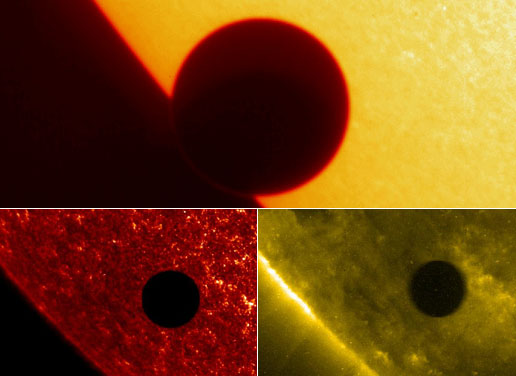
Ingress and Egress
An astronomical transit occurs when one heavenly body appears to pass in front of another as viewed from a vantage point, usually the Earth. When the obscuring body covers most or all of the other celestial body, the event is called an occultation.
This Wednesday, June 6, people in the Philippines will have a chance to witness the transit of Venus with the Sun, an event similar to the one that inspired The Flâneur. The last transit of Venus with the Sun was in 2004, and the next will be in the year 2117, followed by another in 2125; transits of Venus with the Sun are rare events that occur in pairs separated by an 8-year gap.
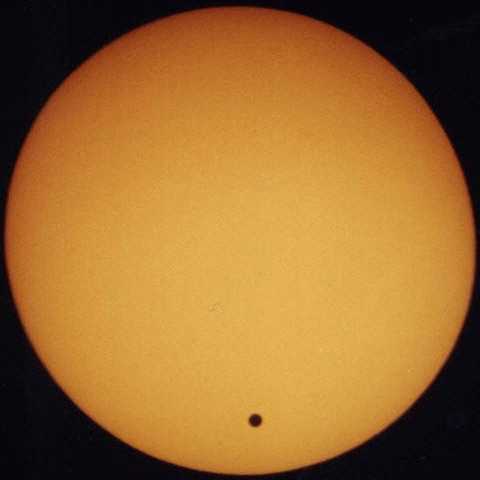
During the transit, Venus will appear as a small dot moving across the disc of the Sun. For more details, see the Appendix of this article or visit the website of the Astronomical League of the Philippines. As viewed from the Philippines, the transit will happen from around 6:00 AM until a quarter to 1:00 PM. However, the precise timing of when the transit begins and ends is very sensitive to the location of the observer. It is for this reason that transits were very important to astronomers. By noting their exact location on Earth, determining the exact timing of the start and end of a transit, and comparing their recorded times with that recorded by other observers, astronomers were able to get a first guess at the distances between the planets and therefore comprehend the nearly incomprehensible scale of the Solar System. (For more on the scale of the Solar System, see this article.)
Another reason why transits are very important is that they help us find extrasolar planets. Extrasolar planets are planets that orbit a star other than our Sun. (Some extrasolar planets do not orbit any star at all, but rather float alone in the cold of interstellar space like a homeless orphan.) How do astronomers use transits to find extrasolar planets? What they do is measure the brightness of a certain star as detected from Earth. For many stars, the level of brightness is fairly constant. However, for some stars a brief period of slight decrease in brightness is detected at regular intervals. This brief dimming can be caused by an orbiting planet undergoing a transit across its mother star.
Even the brightness of the Sun as measured from the Earth’s surface will decrease by a very tiny bit during the transit of Venus, as Venus is partially blocking the rays falling into Earth. The decrease in the Sun’s brightness, however, is very small because Venus is very small compared to the Sun.
So transits of Venus are important and rare astronomical events. Of course many of us want to witness this occurrence, which is why we now discuss the ways of viewing the transit safely.
Viewing the Transit
There are several ways to view this year’s transit safely. The easiest way would be to buy glasses with solar filters. Such glasses are also called eclipse glasses because they also allow you to view solar eclipses without damaging your eyes. Another material that can be used, according to the Astronomical League of the Philippines, is a welder’s glass graded #14. A word of caution: do not look through materials of questionable quality. When you have old solar filters or welder’s glass that are scratched or had their quality compromised in any way, do not use them. If you are in doubt about the ability of a material to protect your eyes, do not look through it. Finally, do not buy “eclipse glasses” from people who do not know their astronomy. The transit of Venus is a must see, but you do not want it to be the last thing you’ll view.
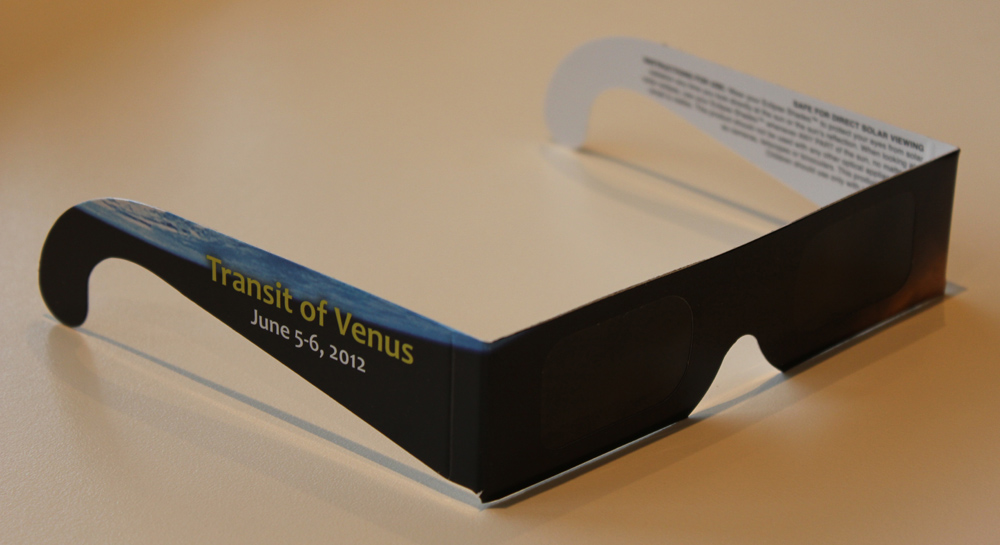
Another way to view the transit is through a pinhole projector. The simplest way of making a pinhole projector is to get two sheets of paper. (Yes, it can be as simple as that!) One sheet of paper will have the pinhole, a small hole measuring around 1-2 millimetres in diameter. The other sheet of paper is where you will project an image of the Sun. To project an image unto the second screen, orient the first screen such that the Sun’s rays hit it directly (that is, so that the rays are perpendicular to it). Next, place the second screen behind the first. So that you could see the projection on the second screen, place it in a dark place. Adjust the distance of the second screen until you obtain the sharpest projection. Below is my pathetic attempt to illustrate the simplest kind of pinhole projector.
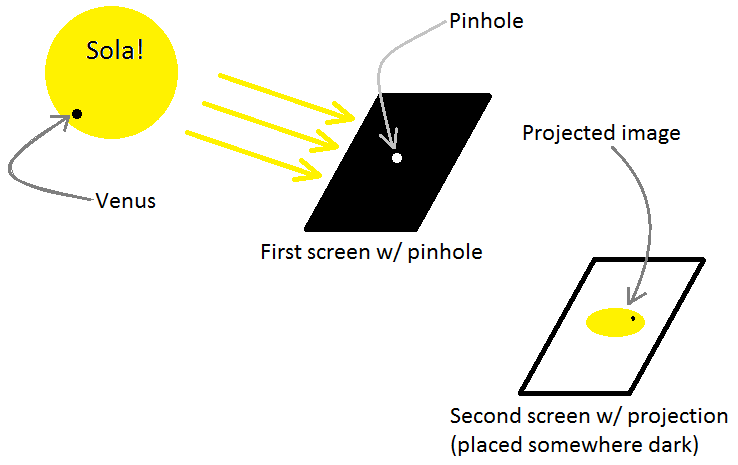
Another, slightly more sophisticated way of making a pinhole projector is to make a long tube (which can be made of cardboard or some other material). Both ends of the tube are covered. However, one end will have a pinhole (1-2 mm) punctured into it. To view the projection at the other end, make a window large enough for you to see the projection. Longer tubes are better. Lengths usually suggested are 6 feet and 1 meter. Below is an illustration of the tube projector.
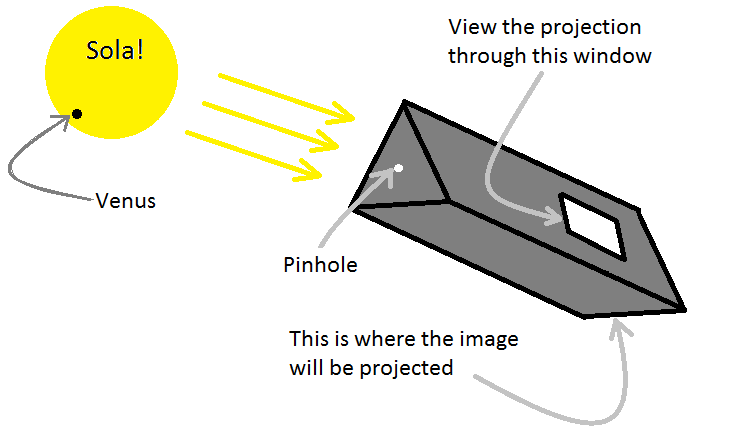
A third way of viewing the transit is by projecting a magnified image of the Sun. For this you’ll need a telescope (either a monocular or a binocular), a projection screen as usual, and simple cover to cast a shadow unto the projection screen. By directed the telescope towards the Sun, a magnified image of the Sun is projected onto the screen. To see this dim projection, use the cover to cast a shadow unto the screen. Below is an illustration.
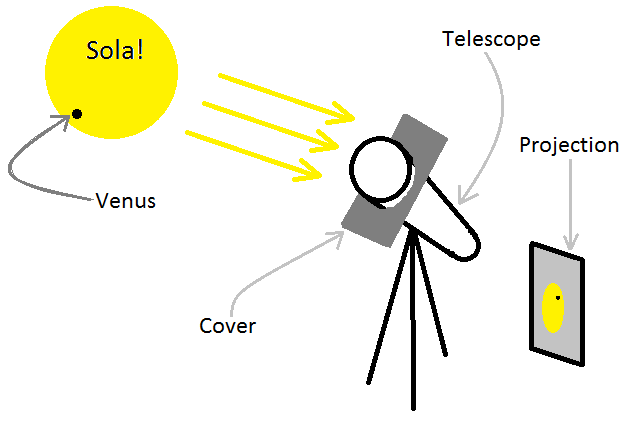
Happy Viewing!
Given the historical significance and rarity of the transits of Venus, I am sure many of you would want to witness this year’s transit for yourself. Just remember, your eyes’s health must still be top priority.
And who knows, your witnessing the 2012 transit might inspire you to pen down your own verse in the same way that Oliver Wendell Holmes was inspired by the 1882 transit.
* * *
Appendix
There are four important events in a transit, and astronomers have special names for them. First comes what is called first contact (or ingress I), when the disc of Venus as seen from the Earth first makes contact with the disc of the Sun. In the Philippines, this will happen at around 6 in the morning. Next comes what is called second contact (ingress II), when Venus is, for the first time, totally within the yellow orb of the Sun. Second contact will come about 27 minutes after first contact. At around 12:30 at noon comes third contact (egress I), when the black dot that is Venus begins to leave the Sun’s face, a process that will be completed come fourth contact (egress II), around 18 minutes after third contact. The precise timing of these events was used by previous generations of astronomers to determine the scale of the Solar System.
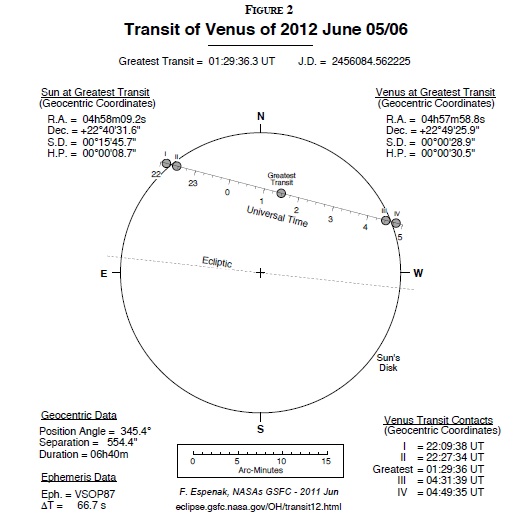
Also, here’s a link to the live stream of the transit.

